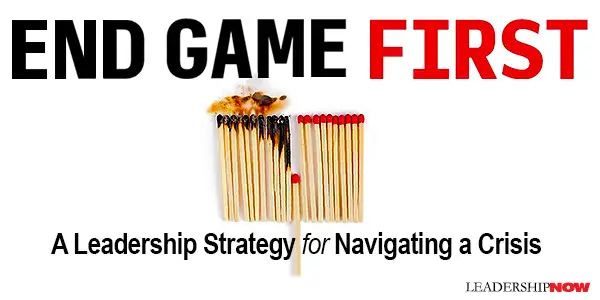 |
 |
03.22.24

End Game First
A CRISIS most often comes when you expect it least. How do you deal with the damage and move forward? Vice Admiral Mike LeFever and Roderick Jones state in End Game First, “In a crisis, you have to consider your end game first. At some point in the future, you will be out of danger and back in the day-to-day. Where do you want to be when that happens?” The end game is your exit strategy. It’s not the end of the crisis, it’s where you want to be after the crisis. It is the result of the actions you take instead of letting the crisis lead you. The end game is about how you will actively shape the outcome. There is risk with any decision made during a crisis, but it is better than standing still. If you don’t identify and act in accordance with the end game, you’re going to be caught unaware when the world moves on without you. The authors identify the four phases of any crisis—a dynamic but predictable path: Phase 1: 911 The opening moments of a crisis require immediate action—most often reactionary action. And that’s normal. But at some point, you will need to step back and observe what is happening so you can develop your strategic end game plan. Once the 911 moment begins, you’ll find yourself reacting any number of challenges. This is when you need to trust your instincts, and your preparations, as you endure the initial chaos. Even with proper planning, this can be a difficult phase. Motions run high, teams grow anxious, and unpredictable turns can come at any time. Information is a powerful currency. In the first phase of a crisis, you need to distinguish between information (raw) and intelligence (analyzed) and to take all new information with a grain of salt. Discordant information abounds in chaos. Phase 2: 2nd and 3rd Order Effects Once the chaos ends, it’s time to address the second and third-order effects. Phase 2 is characterized by moving from reacting to acting—a recovery mindset. A key characteristic of Phase 2 is that none of these solutions are permanent. You are making decisions that move you forward, but they are not the final word on the situation. As a leader, you need to realize when a fix is actually just a bandage. Some solutions also bring new problems. That’s part and parcel for this phase of a crisis. The decisions you make as a leader might plug one leak while creating another. You can’t get discouraged by cascading events, but you need to be aware that can happen. Phase 3: Steady State You’re not out of the crisis yet. “The steady state can lull you into a sense of routine, but you can’t lose focus. You can still make decisions and take actions that move you toward your end goals.” Phase 3 is a steady state of being, but it is not a sustainable environment. Or rather, it can’t be a self-sustainable environment. Steady state is marked by reestablishing some semblance of routine that allows some degree of reset. Phase 4: Reestablishing Normalcy In this phase, you recognize that the crisis is over based on the reality of the situation and dismantle the emergency infrastructure. Exiting a crisis means returning to a changed world. No matter how much you may want it to, life isn’t just going to go back to the way it was. Following a disaster, people change. Priorities change. Infrastructure changes. That’s why your end game needs to take that evolution into consideration. Just as the now exists in the aftermath of the crisis, so must you. Things have changed, and you need to change with them. Knowing which phase you are in will aid you in determining your next move. Each phase comes with its own set of issues. Navigating each with the end game in mind can leave you in a better place than before things began to unravel. While you always need to keep the end in mind, the decisions you make from phase to phase will differ drastically. You not only need to know where you are within the crisis, but how you’ll transition to the next chapter or phase. A crisis will also evolve at different rates for different parts of your organization. It’s important to recognize where the rest of your organization falls within their own scope of the crisis. The authors spend a good deal of time addressing key components of crisis management: building a team, communication, gathering intelligence, creativity in working with what you have to work with, mental health, and relationships. After the crisis is a good time to evaluate what worked and what didn’t. Important, too, is to always be looking for the undercurrents in your industry. Where are you headed? A crisis can accelerate those scenarios. Are you prepared to adapt to the shifts taking place around you? A missed change can create a crisis. It’s hard to know when you’ve become too comfortable with your current situation to objectively step outside of it. That’s why you need more eyes and ears seeking out undercurrents. If you miss it, someone else has a chance to catch it. 
Posted by Michael McKinney at 02:02 PM
|
BUILD YOUR KNOWLEDGE
 

How to Do Your Start-Up Right STRAIGHT TALK FOR START-UPS 
Grow Your Leadership Skills NEW AND UPCOMING LEADERSHIP BOOKS 
Leadership Minute BITE-SIZE CONCEPTS YOU CAN CHEW ON 
Classic Leadership Books BOOKS TO READ BEFORE YOU LEAD |